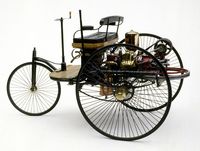125 Years of Innovation: "The Love of Inventing Never Dies" - from the Benz Patent-Motorwagen to the Reinvention of the Motor Car
STUTTGART – December 17, 2010: It was on 29 January 1886 that Carl Benz filed an application in Berlin for a patent on his three-wheeled motor car. Ever since, that day has been considered the official birthday of the motor car, which, in 2011, celebrates its 125th anniversary. At the same time as Benz, Gottlieb Daimler was developing the first four-wheeled motor car. In this way, working independently of each other, the founding fathers of today's Daimler AG and its globally successful Mercedes-Benz core brand laid the foundation stone for all present-day passenger cars, commercial vehicles and buses. The company that invented the motor car has since that time gone on to shape its development more diversely and enduringly than any other motor vehicle manufacturer - in all relevant areas, from drive technology to comfort and safety through to design.
Innovation has always been the key to success for a car manufacturer and is set to become even more important in future. Without the courage to go in search of new ideas, there would be no motor car; and without innovation, there would be no progress. Mercedes-Benz, the inventor of the motor car, has always pressed ahead vigorously with the development of that mode of transport. For instance, the company has repeatedly underpinned its claim to technological leadership with over 80,000 patent applications since 1886, the year in which Carl Benz and Gottlieb Daimler, respectively, unveiled their "Patent-Motorwagen" and "motorised carriage". As the world's first car, the Benz Patent-Motorwagen is the symbol of pioneering spirit par excellence. In its day, the exquisitely engineered three-wheeler made it clear at first sight that a new age of mobility had dawned. Daimler's motorised carriage was the first motor car with four wheels.
These two vehicles represented the start of a unique success story – a story that has continuously had new chapters added to it by Mercedes-Benz. For, time and time again, it has been trendsetting inventions from the Stuttgart-based car manufacturer that have resulted in the "horseless carriage", which was initially said by critics to have "no future", evolving not only into an icon of personal freedom, but also into a significant factor within the economy. Alongside the first bus and the first motor truck, the company's most important innovations also include the first modern passenger car, the Mercedes 35 hp, which was presented in February 1900.
Mercedes 35 hp: the prototype of all modern passenger cars
At the turn of the century, the Mercedes 35 hp, the prototype of all modern passenger cars, was the definition of a fundamentally new and ever since prevailing vehicle architecture: it marked the transition from the long-legged "motor carriage" to the motor car as we know it today. The decisive technical innovations were its long wheelbase, wide track, low centre of gravity and angled steering column. These improvements created the basis for comfortable and safe driving, something that was first turned into reality in a Mercedes.
There are also some characteristic features such as the elongated form and the honeycomb radiator, which, organically integrated into the front end, was to finally solve the hitherto omnipresent problem of how to cool the engine, quite apart from emerging as a distinguishing mark of the brand. With its light-alloy crankcase, the powerful four-cylinder engine served as a model for today's still current lightweight design and was, furthermore, installed low in the frame. Its exhaust valves were controlled by a camshaft, this significantly improving the smoothness of operation, stability at idle and acceleration. The construction principle of "engine at the front, final drive to the rear wheels" was to establish itself in the long term as the conventional drive layout.
The first Mercedes – the first modern-day motor car
The "35 hp" was the first vehicle to sport the Mercedes brand name and went down in history as the first modern-day motor car. Many other manufacturers were to copy this innovative concept, which proved to be superior in every respect. Mercedes-Benz thus from an early date established its claim to be the leader in technology and design.



